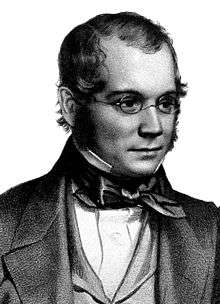David T. Ansted
David Thomas Ansted FRS (5 February 1814 – 13 May 1880) was an English professor of geology and author of numerous books on geology. His role as a teacher at Addiscombe Military Seminary, where future East India Company army officers were trained, had an influence on the study of geology in the colonies.

Youth, education
Ansted was born in London on 5 February 1814 to William Ansted. He was educated at Jesus College, Cambridge, and inspired by Adam Sedgwick took an interest in geology. After taking an MA degree in 1839, he was elected to fellow of the college. He was appointed professor of geology at King's College London in 1840, holding the post until 1853.[1][2][3] From 1845, he was also a lecturer at the East India Company's Military Seminary at Addiscombe (until its closure in 1861), and professor of geology at the College for Civil Engineers at Putney.[1] His Elementary Course of Geology textbook was awarded as a prize to cadets at Addiscombe. The cadets themselves were posted to India and other colonies where some pursued geology.[4]
He became a fellow of the Royal Society in 1844, and from that date until 1847 he was vice-secretary of the Geological Society. The practical side of geology now came to occupy his attention and he visited various parts of Europe as a consulting geologist and mining engineer.[1]
In 1868, Ansted became an Examiner in Physical Geography to the Science and Art Department of King's College. In 1870 he was awarded a Telford Medal by the Institution of Civil Engineers for his paper "On the Lagoons and Marshes of certain parts of the Shores of the Mediterranean".[5]
Travel and writing
Ansted's Gold-Seekers Manual (1849) attempted to improve the prospects of emigrants to the California gold rush. His other published works include Geology, Introductory, Descriptive, & Practical (1844), The Geologist's Text-Book (1845), Syllabus of Lectures on Mineralogy, Geology, and Practical Geology (1848), An Elementary Course of Geology, Mineralogy, and Physical Geography (1850), The Great Stone Book of Nature (1853), The Applications of Geology to the Arts and Manufactures (1865). He was the co-author with Robert Gordon Latham of The Channel Islands (1862).[6][7][8]
By 1853, Ansted's reputation was sufficient that he was hired by potential investors to survey promising coal fields along the New River in southern Virginia in the United States, and he was one of the earlier geologists to identify the rich bituminous coal seams which lay there.[9][10] His work set the stage for a mining boom in the area, where he invested in land along the Midland Trail in Fayette County in what became the new state of West Virginia in 1863 during the American Civil War (1861–65). A protégé of Ansted, William Nelson Page (1854–1932), became a leading industrialist and developer of iron furnaces, coal mines and railroads in the area, leading and managing such enterprises as the Victoria Furnace in Goshen, Virginia and the Gauley Mountain Coal Company for absentee investors, many of whom were based overseas in the United Kingdom.
Ansted collaborated with numerous scientists of the period and like many others he entered into a correspondence with Charles Darwin in about 1860.
Personal life
Ansted married Augusta Dorothea Hackett (1828-1897), daughter of Alexander Baillie on 24 June 1848 and they had six children. Ansted died at Melton near Woodbridge, Suffolk, on 13 May 1880.[1] He is buried in Kensal Green Cemetery, London.[11]
Legacy
The town of Ansted in Fayette County, West Virginia, was named in his honour in 1873.
See also
- William N. Page
- Ansted, West Virginia
- Winding Gulf Coalfield
References
-

- "Ansted, David Thomas (ANST832DT)". A Cambridge Alumni Database. University of Cambridge.
- Stephen, Leslie, ed. (1885). . Dictionary of National Biography. 2. London: Smith, Elder & Co. p. 37.
- Rose, Edward P.F. (2005). "British military geology in India: Its beginning and ending". Royal Engineers Journal. 119: 46–53.
- Ansted, D T (1869). "On the lagoons and marshes of certain parts of the shores of the Mediterranean". Minutes of the Proceedings of the Institution of Civil Engineers. 28 (1869): 287–306. doi:10.1680/imotp.1869.23092.
- "Review of The Channel Islands by D. T. Ansted and R. G. Latham". The Popular Science Review. 2: 381–385. 1862.
- Ansted, D. T.; Latham, R. G. (1865). The Channel Islands (2nd ed.). London: W. H. Allen; with illustrations by Paul J. Naftel
- Sanders, L. C. (1887). Celebrities of the Century: being a dictionary of men and women of the nineteenth century. p. 51.
- Stevenson, J.J. (1877). Second geological survey of Pennsylvania. 1876. Report of Progress in the Fayette and Westmoreland District. Harrisburg. pp. 89–90.
- Ansted, D.T. (1853). Report on the "Wilson survey" near the great Kanawha River, Virginia. New York: W.C.Bryant.
- Thackray, John C. (2015). Ansted, David Thomas (1814–1880), geologist | Oxford Dictionary of National Biography. Oxford University Press. doi:10.1093/ref:odnb/577.
External links
- The Applications of Geology to the Arts and Manufactures (1865)
- The great stone book of nature (1863)
- Scenery, science and art; being extracts from the note-book of a geologist and mining engineer (1854)
- An elementary course of geology, mineralogy, and physical geography (1850)
- The gold-seeker's manual (1849)
- Geology, introductory, descriptive, & practical (1844) Volume 1 Volume 2